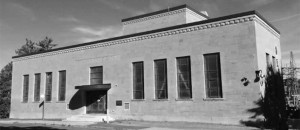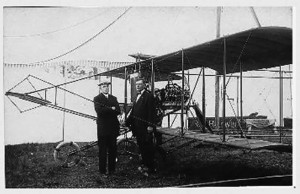Lorne Abugov

The hydro sub-station at 39 Riverdale draws few passing glances from motorists, cyclists and pedestrians, however, it continues to play a central role in the city’s hydro distribution grid and sits on land on which Canadian aviation history was made. Photo By Rick Wallace: Online History Of Ottawa East Photos
These days, it is more often referred to as “that spot to catch the bus on Riverdale” or “the building next to the snowboarding hill at Riverdale and Main”. Shrouded in a bit of mystery, and often overlooked by neighbourhood motorists, cyclists and walkers, the edifice at 39 Riverdale Avenue with a long front façade, double metal front doors and eight regularly spaced, rectangular front windows is about to get some well-earned and overdue public recognition.
Built-in 1946, originally owned by the Ottawa Hydro Electric Commission, and officially known as Hydro Sub-Station Number 5, the squat, stone building that bears resemblance to an oversized mausoleum is the subject of a detailed staff report prepared by the City’s Heritage Section recommending the designation of 39 Riverdale and four other hydro sub-stations as heritage properties under Part IV of the Ontario Heritage Act. The report will come before the City’s Built Heritage Sub-Committee on February 11th and is expected to be heard by City Council on February 26th.

Pilot Lee Hammond (left) pictured with Captain Thomas Baldwin next to his “Red Devil” airplane ON September 11, 1911. Hammond is credited with the first airplane flights in the City of Ottawa, a five minute circuit over the Central Canada exhibition grounds, out to Dow’s Lake, and then landing at Slattery’s Field, which today is the site of Hydro Sub-Station 5 at 39 Riverdale.
Photo By Rick Wallace: Online History Of Ottawa East Photos
The four other Ottawa hydro substations, all built between 1922 and 1946, that have been proposed for heritage designation status are located at 247 Glebe Avenue, 340 Holland Avenue, 1275 Carling Avenue and 351 King Edward Avenue. According to Anne Fitzpatrick, a heritage planner within the City’s Planning, Infrastructure and Economic Development Department, these five sub-stations continue to play a workhorse role in electrical power distribution today, “reducing the voltage carried in transmission lines to levels appropriate for distribution for use throughout the city”.
She notes that the buildings “are excellent examples of industrial buildings influenced by a range of architectural styles and as significant examples of the early to mid 20th-century hydro substations in Ottawa. The sub-stations display a high degree of craftsmanship through architectural details such as stone panels with the building’s name, metal entrance canopies suspended by chains, stone and copper detailing, decorative parapet rooflines and large often round-arched, windows.”
The staff report concludes that 39 Riverdale Avenue satisfies all three evaluation criteria for heritage designation: Design or Physical Value; Historic and Associative Value; and Contextual Value.
Regarding the Design Value criterion, the report states that 39 Riverdale is “… an excellent example of an industrial building influenced by the Streamlined Moderne variant of the Art Deco style and is a significant example of the early to mid 20th-century hydro sub-stations in Ottawa. The Streamlined Moderne style was popular in the 1920s until the mid-1940s. The style featured bold masses, smooth finishes and occasionally traces of the classical style. Typical of its style, Hydro Sub-Station No. 5, features smooth surfaces, symmetry and stylized dentils.
“The front entrance consists of double metal front doors with sidelights, a curved metal canopy and a central window above the door. There is a stone panel above the door that reads “Ottawa Hydro Electric”. Other notable architectural details include the dentilled stone banding at the roofline, stone sills, and subtle stone quoining on corners and around windows,” note City staff in the report, which concludes that the building “retains a high degree of architectural integrity.”.

Another aviation first –the maiden flight of inter-City mail delivery between Ottawa and Montreal on October 9, 1913 – took place at Slattery’s Field; the milestone was captured in this photo of the Vought/Lillie biplane flown by pilot William C. Robinson. Photo By Rick Wallace: Online History Of Ottawa East Photos
In building a case for satisfying the Historic Value criterion, the detailed report sheds fascinating light on the history associated with the building, its location and the development of electrical power in Ottawa in the late 19th and early 20th century.
For example, in relation to the history of electrical power in the City, the report states: “Electric lighting came to the Ottawa in 1882 when two carbon lamps were erected in the lumber yards of Lebreton Flats near Chaudière Falls. By May 1, 1885, Ottawa was the first city in the world to have all its streetlights lit with electricity, replacing the oil-fueled lamp posts.
“The business of electricity generation and distribution was lucrative, and several companies were quickly established by the business and political elites in the city.” Among those who dove headlong into the scramble to gain control of the Ottawa power franchise in the late 1800s were notables such as E.H. Bronson, Francis Clemow, Thomas Ahearn and Warren Y. Soper.
Political frustration caused by early monopolization of electrical service and resulting high electricity rates led eventually to the establishment of a municipally-owned enterprise in 1916, the forerunner of Ottawa Hydro, known as the Ottawa Hydro-Electric Commission, which was the original owner and builder of 39 Riverdale. When in 1950, the City-owned electrical company purchased its last-surviving private competitor, citizens of Ottawa could truthfully boast that they paid the lowest average electricity rates in the world, as reported in the Ottawa Journal on May 9, 1951.
Equally noteworthy is the location at 39 Riverdale, which was a former farmer’s field known as Slattery’s Field owned by the Slattery family who resided on the north side of Riverdale at the corner of Main, and who ran a successful livestock operation on their farmlands and a butcher store in the Byward Market. As the report chronicles, Slattery’s

Today, area youth take advantage of the sloping terrain beside the hydro substation at Riverdale Avenue and Main Street for use as a snowboarding run. Photo by Lorne Abugov
The field is the site of two of Canada’s most historic aviation events: “Slattery’s Field … is the site of the first airplane flight in the Ottawa region. Between September 11-14, 1911, pilot Lee Hammond flew a biplane and performed for crowds as part of the Central Canada Exhibition. Later, on October 8, 1913, the first flight between two Canadian cities landed here (at Slattery’s Field) after flying from Montreal. The plaque on the building (at 39 Riverdale) from the Canadian Aviation Historical Society notes that “both pilots had to contend with cows and horses, which shared the crude airfield”.
Not to be forgotten is the design work of noted Ottawa architect, J. Albert Ewart, who worked in the city from the turn of the century until the late 1950s. In addition to designing the sub-station at 39 Riverdale, Ewart also designed the Ottawa Electric Building (1926) on Sparks Street, the Ottawa Civic Hospital (1924), and Southminster Church (1931) on Bank Street
![]() If readers have any comments they wish to submit to the Built Heritage Sub-Committee regarding the 39 Riverdale Avenue hydro sub-station, they can be provided to Anne Fitzpatrick (Anne.Fitzpatrick@ottawa.ca) and Eric Pelot (Eric.Pelot@ottawa.ca), Committee Coordinator, anytime before the February 11th meeting.
If readers have any comments they wish to submit to the Built Heritage Sub-Committee regarding the 39 Riverdale Avenue hydro sub-station, they can be provided to Anne Fitzpatrick (Anne.Fitzpatrick@ottawa.ca) and Eric Pelot (Eric.Pelot@ottawa.ca), Committee Coordinator, anytime before the February 11th meeting.






